Two electrical sockets work in Sharon Moss's four-bedroom house in Letterkenny.
From one, an extension lead feeds the kitchen; from the other, a cable reel trails through the sitting room and the hall to upstairs.
"On a bad day, the rain will hit the [outside] walls and because there's so much plaster work off, it comes through, and it'll trip them."
Defective building blocks have destroyed the structure of the Moss family home, and much of what is within it.
"I'm bringing up two boys in this house, and we shouldn't be living like this. It is 2023, and we should not be living in this house," Sharon told Prime Time.
Yet she is living there, and for years has watched the house disintegrate around her. Just one of the problems she and her husband have faced would be a homeowners’ worst nightmare, but in recent times, another problem grew.
"The smell of the house is just unreal," Sharon said. "You can't use rooms and you can't get the mould off. We're breathing this in, and we don't know how our health is going to be."
Watch: Mould is an increasing problem in homes built with defective blocks.
Thousands of houses in Donegal and hundreds in other counties have been built with bad blocks containing damaging levels of minerals mica, pyrite and another highly reactive material, pyrrhotite.
It is estimated the final cost of redress for the damage to homes caused by such defective products could top €4bn over the coming years.
An enhanced government grant scheme was launched in July to fund much, but not all, of the cost of repairing or rebuilding. Under it, homeowners in Donegal, Clare, Mayo and Limerick affected by defective blocks containing excessive amounts of the minerals mica and pyrite can apply for financial help.
But payments through the scheme are made in stages, and works must be completed and signed off by a professional such as an engineer before interim payment claims can be submitted. This means that in practice, families must often bear much of the initial costs before they can seek money back from the grant scheme.
While some money has been paid out to the Mosses, the process is moving far too slowly for them, and many affected owners.
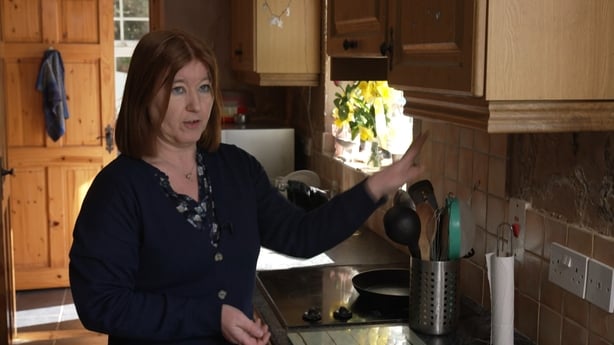
Sharon Moss has been advised that the electrics in the house are dangerous, that there are excessively high levels of the toxic mould, Aspergillus/Penicillium, in her home and that she and her family should move out.
Prime Time filmed with the family in February. We asked Sharon Moss "why haven't you moved out?"
"Because we were waiting on government funding. We've had some groundwork done that we had to get sorted ourselves, and get a mobile home to put on that. So, we are just waiting now on the next part", she said.
Come September, her situation is still stalled. There are problems; the second-hand mobile home they bought has not been moved on site. The groundworks they installed for it are too close to the house for safe demolition, they have been advised.
Neither she nor her husband are project managers or experienced in these things, she pointed out.
In one respect though, she is one of 'the lucky ones': the couple managed to clear their mortgage. "We own a crumbling mess", she said.
But many other affected owners are repaying their mortgage each month on homes that are falling apart, or demolished and gone.

Homeowners are increasingly concerned not just about families' mental health, but their respiratory health too.
Systemic delay in addressing disintegrating homes is giving time for more cracks, more moisture ingress, and therefore more risk of damp and mould.
Exposure to mould can increase the risk of a range of respiratory health issues and for those with pre-existing conditions, it can make them worse.
In Mayo, outside Belmullet, Peter Hefferon lives in a mould-ridden home constructed with blocks containing excessive pyrite. Both he and his son have asthma.
There are no standards for testing or analysing mould in residential homes in Ireland or the EU, but air sampling carried out to USA standards in January this year inside Peter Hefferon's house found elevated fungal spores of Aspergillius Penicillium.
Outside, the cause of the problem is obvious. The defective block walls are crumbling under the weight of the roof.
"It’s heartbreaking. It is a lot of stress and anxiety and everything on a person. Like, not alone am I suffering from chest problems and lung problems, but the stress alone, it’s just unreal."
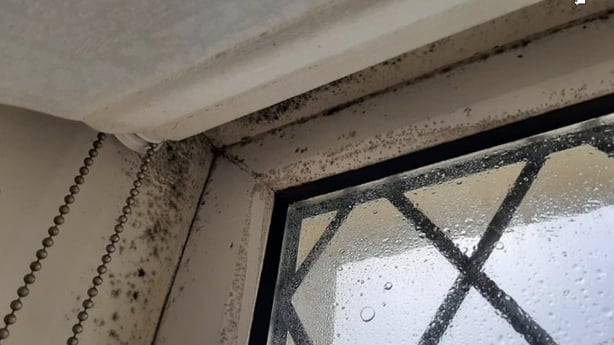
Permanent TSB sold Peter's mortgage to Pepper Mortgages, a vulture fund that does not provide loans. With the house itself valueless due to the defective blocks, he doubts he could get a loan from any other bank.
He has shutters installed in the frames of his PVC windows, because some window panes blew in during winter storms last year. He has had expanding silicon injected into exterior cracks to keep water out, but lichen and moss growth is already to be seen under last year’s silicon repairs.
He is at a loss as to what to do.
"I used to get chest infections, but now the chest infections are getting more serious all the time," he said.
"I ended up in Mayo University Hospital the last few years, about eight times from chest infections".
In addition to having his lungs "flushed out", he and his son have nebulisers, and there are air filtration machines in their bedrooms.
Down the road from Peter Hefferon, Paul and Agie Neary bought their house in 2007. It too has reactive pyrite in its blocks. Inside, damp and mould congregate. Agie is constantly cleaning away mould. In July, she moved some shoe boxes away from a radiator in her son’s bedroom – and found mushrooms growing there.

Some homeowners with crumbling homes who have been forced to go ahead with demolition have put themselves into further debt because the scheme is moving too slowly.
In the townland of Ray in Donegal, it's two years since Joe and Elaine Morgan’s house was approved for demolition under the Defective Blocks Grant scheme, but they are still waiting to get money.
"Not one cent from the scheme to date," says Joe. "We’re still waiting on the local authority to approve our access to draw down funds."
This year, they went ahead with the demolition themselves. "We could not wait any longer, we had to get out of the house. We didn't feel safe in it", said Joe.
They have paid out €64,000 to demolish the house and erect mobile homes to temporarily live in. Meanwhile, they are still paying a mortgage with a further 15 years remaining on it for a house reduced to a pile of rubble and now gone.
But having knocked down their home, they are stuck. They have exhausted all funds and cannot afford to build again without funding from the scheme.
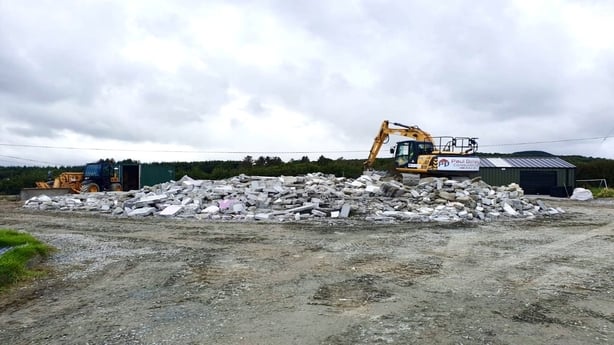
Across the water, on the Inishowen peninsula, Donna McDade is in debt, due to delay. She too has had her house demolished this year.
Donna and her husband Ian were approved under the grant scheme and got €5,000 for storage costs and €15,000 towards rent, but as they had to move out of their home in August 2022, after 13 months renting and paying for storage, that money is long gone.
They have also had four interim payments under the scheme since January for works completed and signed off by her engineer. But to get her house rebuild underway, she's had to borrow over €67,000.
"We’ve the €50,000 that we've borrowed from the credit union, my parents have lent us €12,000, and there, literally about five weeks ago, I had to put a deposit for windows on a credit card, so that we can have that order in place; otherwise, we're not going to have the house sealed prior to the winter", she said.
On top of that, she is still paying €1,260 per month mortgage repayments "on the property that no longer exists".
The rebuild of her house has so far been substantially funded by a credit union loan for, first €30,000 and then a further €20,000.
"Our credit union loan is classified as a home improvements loan, ironically, and that is at 7.99%. So, over the duration of the loan that we've borrowed, which is now €50,000, we will actually be paying back about €14,000 interest on top of that", she said.
Since July though, work has stopped, and the building site is closed. She cannot afford to do more.
The enhanced redress scheme was launched eight weeks ago, but Donna is still waiting to be transferred onto it – otherwise she could be at the mercy of credit card rates for the remaining cost of her new windows.
As things stand, Donna and Ian are now paying three ways for their home: for the mortgage on the demolished house; a credit union loan for the new build; and rent for their temporary home.
Her circumstances reflect a broader concern amongst affected homeowners that their banks, benefitting from the state redress scheme and the efforts and savings or borrowings of homeowners, are doing little to help.
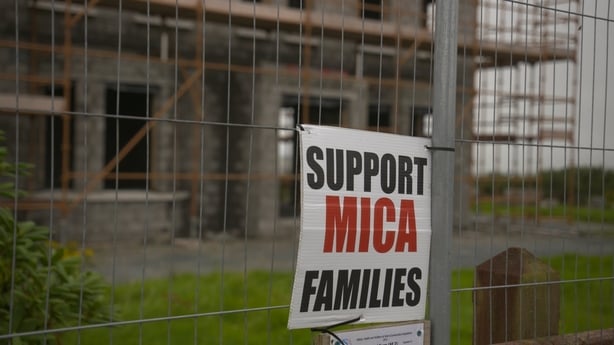
Donna McDade feels that the banks are content to leave homeowners to fix the problem with their housing assets, while insisting that normal lending terms and conditions apply.
She and a group of other homeowners are in a banking and insurance focus group that has been engaging with the banks to try to get them to offer short-term bridging loans at low or zero interest rates to help homeowners take the necessary steps that will allow them to access the grant scheme.
The Department of Housing told Prime Time it was aware of potential issues with bank lending and has in recent weeks met with the banking sector with a view to "developing a suitable product that would help homeowners who may experience challenges in accessing loan finance in the short-term."
The Minister for Finance has also raised the issue with the banking sector.
In a statement, the Banking Payments Federation said that it was committed to work with the Department of Housing to understand the practical operation of the redress scheme and "to explore all options".
It said a range of supports were made available by banks on a case-by-case basis, "including in some cases forbearance such as payment breaks or staged payment mortgages."
However, affected homeowners say that mortgage breaks at the same or increasing rates do not represent a solution.
In addition to bridging loans, they are also asking banks to provide longer-term loans or top-up facilities at low interest rates so that costs above and beyond the grant scheme's €420,000 cap can be covered.
They point out that the total cap includes demolition, alternative accommodation and various other costs that do not go towards the actual new build. With building inflation, there are already significant shortfalls showing up.
One relates to the basic starting rules of the scheme itself. Redress covers repair, replacement or demolition, but does not cover the cost of replacing foundations or rebuilding to current building regulations. It is supposed to be a direct, like-for-like repair or replacement of a house. In practice, that is not possible. Building standards, and materials, have moved on, as has their price
In Letterkenny, Sharon Moss’s house highlights the effect of this in practice.
Professor Paul Dunlop of the University of Ulster and a team of international scientists examined block samples from a small number of houses in Inishowen last year.
They found mica and the highly reactive mineral, pyrrhotite in block. However, the state grant scheme currently does not cover removal and replacement of foundations.
The scientists also looked at the outer and inner leaf of exterior walls of Donegal house samples and found clear evidence of the presence of pyrrhotite. That’s a concern, because many houses have been approved for repair, not demolition, and pyrrhotite is a significant threat.
Both mica and pyrrhotite were found in separate block samples taken from Sharon Moss's walls and from beneath her ground floor.
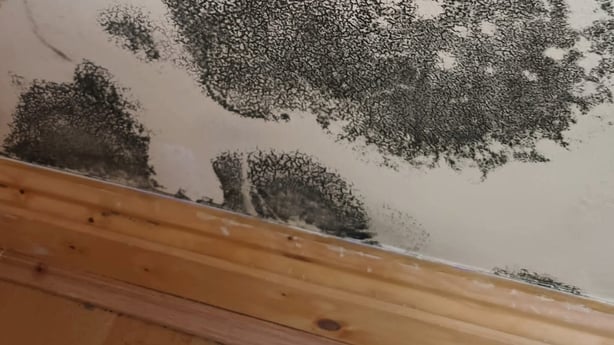
Professor Dunlop told Prime Time: "The current situation is that people in Donegal have to get their houses tested for high content of mica. Now, when the scheme was developed, that was okay. But new science has come out now to show that there's actually more things going on in the concrete blocks than was thought initially. There's different types of deleterious minerals, particularly this one, pyrrhotite, which is quite unstable. So, the redress scheme has to move with the science."
Professor Dunlop is jointly leading further, detailed, research that should inform discussions about the issue.
In the meantime, he told Prime Time that in some houses, where the decision has been taken to replace outer leaf walls rather than demolish the homes, "there are risks associated with that".
"Effectively, we have a situation in Ireland where we have a scheme that's been developed to repair people's homes before we actually understand what's actually happening in the walls. And I think that that's really problematic", he said.
A report by Rita O'Reilly on the impact on families of defective blocks is broadcast on Prime Time on Tuesday 5 September.





